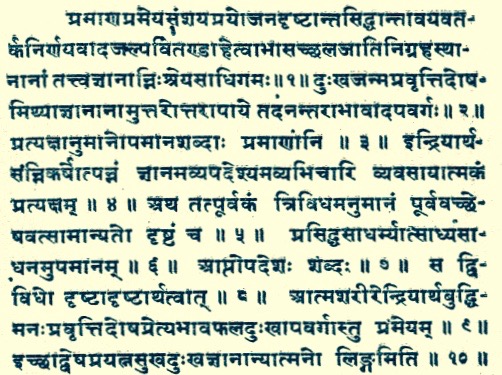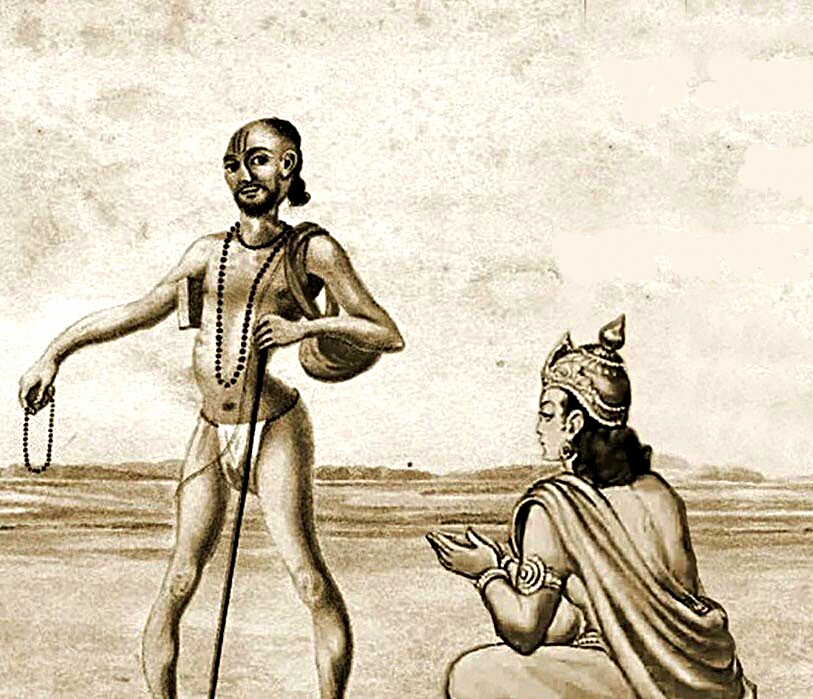|
Nyāya
(Sanskrit: न्याय, ''nyā-yá''), literally meaning "justice", "rules", "method" or "judgment",Nyaya: Indian Philosophy Encyclopædia Britannica (2014) is one of the six '' astika'' schools of . This school's most significant contributions to Indian philosophy were systematic development of the theory of , methodology, and its treatises on epistemology. [...More Info...] [...Related Items...] OR: [Wikipedia] [Google] [Baidu] |
Nyāya Sūtras
The ''Nyāya Sūtras'' is an ancient Indian Sanskrit text composed by , and the foundational text of the Nyaya school of Hindu philosophy. The date when the text was composed, and the biography of its author is unknown, but variously estimated between 6th-century BCE and 2nd-century CE.Jeaneane Fowler (2002), Perspectives of Reality: An Introduction to the Philosophy of Hinduism, Sussex Academic Press, , page 129 The text may have been composed by more than one author, over a period of time. The text consists of five books, with two chapters in each book, with a cumulative total of 528 aphoristic sutras, about rules of reason, logic, epistemology and metaphysics.Jeaneane Fowler (2002), Perspectives of Reality: An Introduction to the Philosophy of Hinduism, Sussex Academic Press, , pages 127–136 The Nyāya Sūtras is a Hindu text, notable for focusing on knowledge and logic, and making no mention of Vedic rituals. The first book is structured as a general introduction and ... [...More Info...] [...Related Items...] OR: [Wikipedia] [Google] [Baidu] |
Udayana
Udayana, ( Devanagari: उदयन) also known as Udayanācārya (Udyanacharya, or Master Udayana), (circa 975 - 1050 CE) was an Indian philosopher and logician of the tenth century of the Nyaya school who attempted to devise a rational theology to prove the existence of God using logic and counter the attack on the existence of God at the hands of Buddhist philosophers such as Dharmakīrti, Jñānaśrī and against the Indian school of materialism (Chārvaka). He is considered to be the most important philosopher of the Nyāya tradition. He worked to reconcile the views held by the two major schools of logic (Nyaya and Vaisheshika). This became the root of the Navya-Nyāya ("New Nyāya") school of the thirteenth century, established by the Gangesha Upadhyaya school of "right" reasoning, which is still recognized and followed in some regions of India today. He lived in Kariyan village in Mithila, near present-day Darbhanga, Bihar state, India. Udayana wrote a sub-glos ... [...More Info...] [...Related Items...] OR: [Wikipedia] [Google] [Baidu] |
Vaisheshika
Vaisheshika or Vaiśeṣika ( sa, वैशेषिक) is one of the six schools of Indian philosophy (Vedic systems) from ancient India. In its early stages, the Vaiśeṣika was an independent philosophy with its own metaphysics, epistemology, logic, ethics, and soteriology. Over time, the Vaiśeṣika system became similar in its philosophical procedures, ethical conclusions and soteriology to the Nyāya school of Hinduism, but retained its difference in epistemology and metaphysics. The epistemology of the Vaiśeṣika school of Hinduism, like Buddhism, accepted only two reliable means to knowledge: direct observation and inference. the Vaiśeṣika school and Buddhism both consider their respective scriptures as indisputable and valid means to knowledge, the difference being that the scriptures held to be a valid and reliable source by Vaiśeṣikas were the Vedas. The Vaisheshika school is known for its insights in naturalism.Kak, S. 'Matter and Mind: The Vaisheshika S ... [...More Info...] [...Related Items...] OR: [Wikipedia] [Google] [Baidu] |
Indian Philosophy
Indian philosophy refers to philosophical traditions of the Indian subcontinent. A traditional Hindu classification divides āstika and nāstika schools of philosophy, depending on one of three alternate criteria: whether it believes the Vedas as a valid source of knowledge; whether the school believes in the premises of Brahman and Atman; and whether the school believes in afterlife and Devas. There are six major schools of Vedic philosophy— Nyaya, Vaisheshika, Samkhya, Yoga, Mīmāṃsā and Vedanta, and five major heterodox (sramanic) schools— Jain, Buddhist, Ajivika, Ajñana, and Charvaka. However, there are other methods of classification; Vidyaranya for instance identifies sixteen schools of Indian philosophy by including those that belong to the Śaiva and Raseśvara traditions.Cowell and Gough, p. xii.Nicholson, pp. 158-162. The main schools of Indian philosophy were formalised and recognised chiefly between 500 BCE and the late centuries of the Common Era ... [...More Info...] [...Related Items...] OR: [Wikipedia] [Google] [Baidu] |
Bimal Krishna Matilal
Bimal Krishna Matilal (1 June 1935 – 8 June 1991) was an eminent British-Indian philosopher whose writings presented the Indian philosophical tradition as a comprehensive system of logic incorporating most issues addressed by themes in Western philosophy. From 1977 to 1991, he was the Spalding Professor of Eastern Religion and Ethics at the University of Oxford. Education Literate in Sanskrit from an early age, Matilal was also drawn towards Mathematics and Logic. He was trained in the traditional Indian philosophical system by leading scholars of the Sanskrit College, where he himself was a teacher from 1957 to 1962. He was taught by scholars like pandit Taranath Tarkatirtha and Kalipada Tarkacharya. He also interacted with pandit Ananta Kumar Nyayatarkatirtha, Madhusudan Nyayacharya and Visvabandhu Tarkatirtha. The ''upadhi'' (degree) of Tarkatirtha (master of Logic) was awarded to him in 1962. While teaching at the Sanskrit College (an affiliated college of the Uni ... [...More Info...] [...Related Items...] OR: [Wikipedia] [Google] [Baidu] |
Logic
Logic is the study of correct reasoning. It includes both formal and informal logic. Formal logic is the science of deductively valid inferences or of logical truths. It is a formal science investigating how conclusions follow from premises in a topic-neutral way. When used as a countable noun, the term "a logic" refers to a logical formal system that articulates a proof system. Formal logic contrasts with informal logic, which is associated with informal fallacies, critical thinking, and argumentation theory. While there is no general agreement on how formal and informal logic are to be distinguished, one prominent approach associates their difference with whether the studied arguments are expressed in formal or informal languages. Logic plays a central role in multiple fields, such as philosophy, mathematics, computer science, and linguistics. Logic studies arguments, which consist of a set of premises together with a conclusion. Premises and conclusions are usu ... [...More Info...] [...Related Items...] OR: [Wikipedia] [Google] [Baidu] |
Ancient Mithila University
Ancient Mithila University was an Indian historical university famous for Nyaya Shastra and logical sciences. Background Gurukuls of the Vedic period in India can be called the ancient form of university because they had a system of higher education. Later, in the Upanishads and the Brahmanical period, we find the "Council" functioning as a university. These councils held conferences of scholarly teachers and students and were authorized to confer degrees. The Ancient Mithila University was gradually started from the philosophical conferences held by Janaka, the king of Mithila at his court. There was a council of philosophical Conferences in the Mithila know as Mithila Darshanik Sammelan Parishad. The council was founded by the King Janaka at his court. The council was holding philosophical conferences at the court of the King Janaka. These philosophical conferences led to the formation of a seat of learning and this seat of learning converted into the university of Mithil ... [...More Info...] [...Related Items...] OR: [Wikipedia] [Google] [Baidu] |
Pramana
''Pramana'' (Sanskrit: प्रमाण, ) literally means "proof" and "means of knowledge".pramANa Sanskrit-English Dictionary, Koeln University, GermanyJames Lochtefeld, "Pramana" in The Illustrated Encyclopedia of Hinduism, Vol. 2: N-Z, Rosen Publishing. , pages 520-521 In Indian philosophies, pramana are the means which can lead to knowledge, and serve as one of the core concepts in Indian . It has been one of the key, much debated fields of study in , |
Metaphysics
Metaphysics is the branch of philosophy that studies the fundamental nature of reality, the first principles of being, identity and change, space and time, causality, necessity, and possibility. It includes questions about the nature of consciousness and the relationship between mind and matter, between Substance theory, substance and Property (philosophy), attribute, and between potentiality and actuality. The word "metaphysics" comes from two Greek words that, together, literally mean "after or behind or among [the study of] the natural". It has been suggested that the term might have been coined by a first century CE editor who assembled various small selections of Aristotle's works into the treatise we now know by the name Metaphysics (Aristotle), ''Metaphysics'' (μετὰ τὰ φυσικά, ''meta ta physika'', 'after the Physics (Aristotle), ''Physics'' ', another of Aristotle's works). Metaphysics studies questions related to what it is for something to exist an ... [...More Info...] [...Related Items...] OR: [Wikipedia] [Google] [Baidu] |
Ātman (Hinduism)
''Ātman'' (; sa, आत्मन्) is a Sanskrit word that refers to the (universal) Self or self-existent essence of individuals, as distinct from ego (''Ahamkara''), mind (''Citta'') and embodied existence (''Prakṛti''). The term is often translated as soul, but is better translated as "Self," as it solely refers to pure consciousness or witness-consciousness, beyond identification with phenomena. In order to attain moksha (liberation), a human being must acquire self-knowledge ('' Atma Gyaan or Brahmajnana''). ''Atman'' is a central concept in the various schools of Indian philosophy, which have different views on the relation between ''Atman'', individual Self ('' Jīvātman''), supreme Self ('' Paramātmā'') and, the Ultimate Reality ('' Brahman''), stating that they are: completely identical ( Advaita, Non-Dualist), completely different ( Dvaita, Dualist), or simultaneously non-different and different (Bhedabheda, Non-Dualist + Dualist). The six orthodox s ... [...More Info...] [...Related Items...] OR: [Wikipedia] [Google] [Baidu] |
Sanskrit
Sanskrit (; attributively , ; nominally , , ) is a classical language belonging to the Indo-Aryan languages, Indo-Aryan branch of the Indo-European languages. It arose in South Asia after its predecessor languages had Trans-cultural diffusion, diffused there from the northwest in the late Bronze Age#South Asia, Bronze Age. Sanskrit is the sacred language of Hinduism, the language of classical Hindu philosophy, and of historical texts of Buddhism and Jainism. It was a lingua franca, link language in ancient and medieval South Asia, and upon transmission of Hindu and Buddhist culture to Southeast Asia, East Asia and Central Asia in the early medieval era, it became a language of religion and high culture, and of the political elites in some of these regions. As a result, Sanskrit had a lasting impact on the languages of South Asia, Southeast Asia and East Asia, especially in their formal and learned vocabularies. Sanskrit generally connotes several Indo-Aryan languages#Old Indo- ... [...More Info...] [...Related Items...] OR: [Wikipedia] [Google] [Baidu] |
Anuvyavasaya
Anuvyavasāya (Sanskrit:अनुव्यवसाय) is derived from ''anu'' ('after') + ''vyavasāya'' ('contact') – which means - 'after contact' or 'self reflective cognition' or 'cognition of a cognition'. Abhinavagupta has used this term to designate the re-presentation of what has been presented repeatedly as a dramatic representation. In Yoga psychology, it refers to the function of the mind in its intelligent ('' sāttvika'') aspect by which the sensations (due to the sense-object contact ''ālochana'') are associated, differentiated, integrated, and assimilated into precepts and concepts; it refers to the creative faculty of the mind, and also accepted by Dignāga and Dharmakirti of the Yogacara and the Sautrāntika schools of Buddhism respectively. The former held the view that the nature of a reality is absolute consciousness devoid of any subject-object relations that are the constructs of the mind and expressed in language. However, the Nyāya realists did not ac ... [...More Info...] [...Related Items...] OR: [Wikipedia] [Google] [Baidu] |






